Growing Potentilla ‘Cinquefoils’: A Shrub Suited To A Wide Range Of Garden Backdrops

SHRUBS > POTENTILLA
Chris is a gardening writer and nature enthusiast. He graduated from Oxford Brookes University in 2022 with an MA in Psychology. Chris works with the Leeds Green Action Society, helping their food cooperative by growing various fruit and vegetables on their two allotments in Hyde Park, Leeds.
Reviewed By COLIN SKELLY

Colin is a Horticulturist and Horticultural Consultant with experience in a range of practical and managerial roles across heritage, commercial and public horticulture. He holds the Royal Horticultural Society’s Master of Horticulture award and has a particular interest in horticultural ecology and naturalistic planting for habitat and climate resilience.
IN THIS GUIDE
Some plants have so many names that it can be hard to keep track of them, and potentilla is one such candidate.
You’ll see this plant variously referred to as potentilla, cinquefoil, five fingers, silverweeds, and more.
Throwing further confusion into the mix is that many varieties are visually similar, centred on a theme of being small, green shrubs with vigorous bouquets of yellow flowers.
What is certain, however, is that potentilla makes a pretty addition to any garden.
Overview
| Botanical Name | Potentilla |
| Common Name(s) | Cinquefoils |
| Plant Type | Perennial, Annual, Shrub |
| Native Area | Northern Hemisphere |
| Hardiness Rating | Mostly H7 |
| Foliage | Deciduous |
| Flowers | 5 petalled flowers appearing over a long period |
| When To Sow | March, April |
| Flowering Months | June, July, August, September |
| When To Prune | August, September |
Sunlight
Preferred
Full Sun
Exposure
Exposed or Sheltered
Size
Height
0.1 – 0.5M
Spread
0.1 – 0.5M
Bloom Time
June – September
Soil
Preferred
Most Soil Types
Moisture
Moist but well drained
pH
Any
This genus contains an undefined number of plants – with estimates ranging by source from three hundred to over five hundred – and there’s contention about the characteristics which should define membership.
As a current guide, Kew lists 501 species of Potentilla.1Potentilla. (n.d.). Plants of the World Online. Retrieved July 31, 2023, from https://powo.science.kew.org/taxon/urn:lsid:ipni.org:names:30000237-2#children
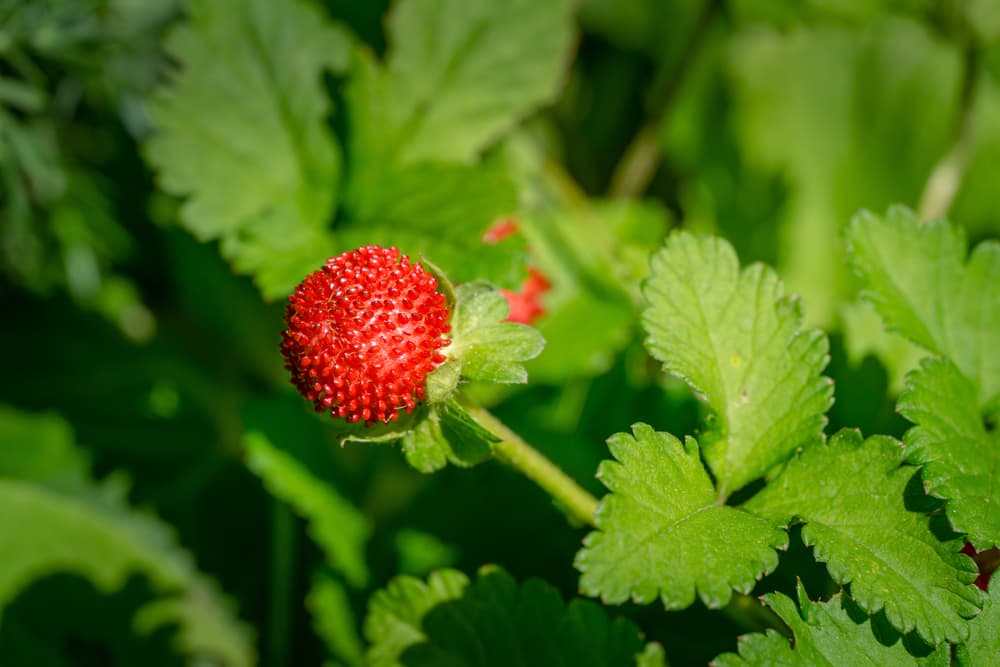
Some potentillas have small berries which resemble strawberries – a plant to which they’re closely related – but the fruit is small and inedible.
All varieties have an elegant floral bloom, yet while the majority are yellow, the overall colour palette varies wildly.
Why Grow Potentilla?
For a budding British gardener, this is the more important question.
We advocate growing potentilla because it is attractive, varied, and well-suited to a wide range of garden backdrops.

Their low shrub profiles lend themselves nicely to borders, while their bold colouration adds visual interest to flower beds and displays.
Potentilla Varieties
There are potentially hundreds of different types of Potentilla.
Each of the three varieties below have been awarded the RHS Award of Garden Merit: an accolade indicating particular suitability to growth in British gardens.
If you’re wondering which potentilla to grow, you won’t go far wrong with one of these.
P. fruticosa ‘King Cup’

What do we think of when we think of royalty?
Bold, regal colours, confidence, and more than a smattering of gold.
With these criteria in mind, it’s not hard to see where ‘King Cup’ got its name.
The rich yellow bloom that bursts forth in summer and sticks around well into autumn sets the potentilla scene perfectly.
P. fruticosa ‘Medicine Wheel Mountain’
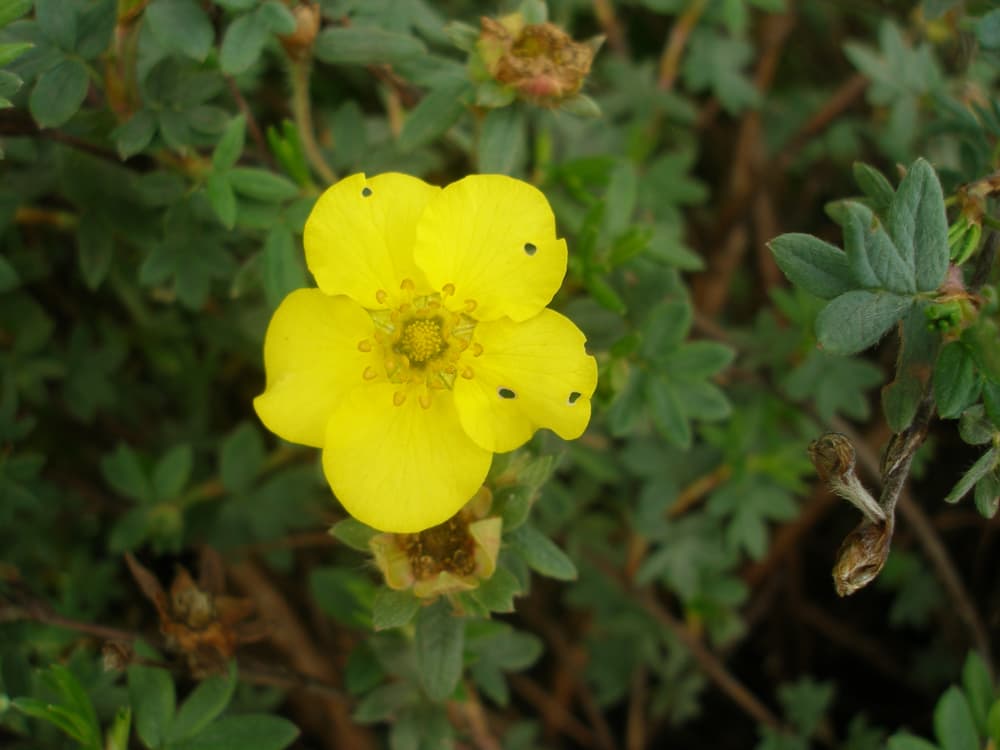
Here we have a mat-forming shrub which spills intriguingly out onto the ground, leaving a green-yellow covering.
The dimensions and overall aesthetic of the mat would work well with a rock display, or to provide attractive ground cover somewhere in your garden that doesn’t require much of a vertical contribution.
P. fruticosa ‘Primrose Beauty’
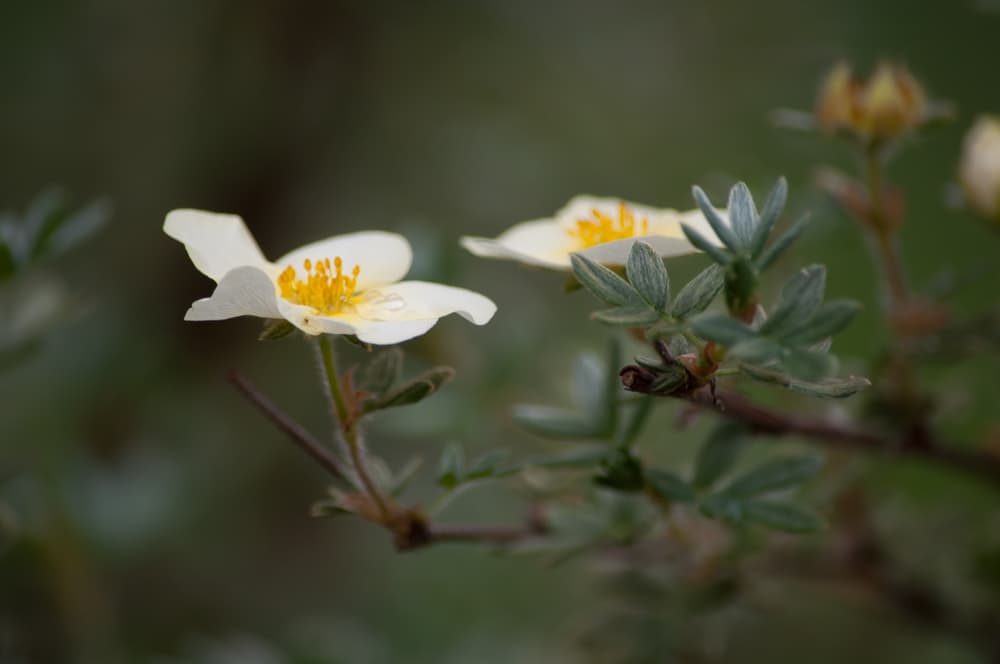
This variety of potentilla has white flowers with bright yellow centres, rather than fully yellow flowers.
With ‘Primrose Beauty’ you can get a good idea of the variations available within the potentilla colour palette.
Not every garden needs more yellow, but we think that any garden could do with a dash of potentilla.
How To Grow Potentilla
If you’re sold on potentilla and want to get one growing in your garden, the next sections are for you.
We’ll outline where to plant it, how often to water it, methods of propagation, and much more.
Where To Grow
The answer to this question will depend on the variety you choose.
Potentillas range in height from a few inches to several feet, and have a similarly broad range of widths.
Take time to understand how big your variety is likely to get and choose a space in your garden accordingly.
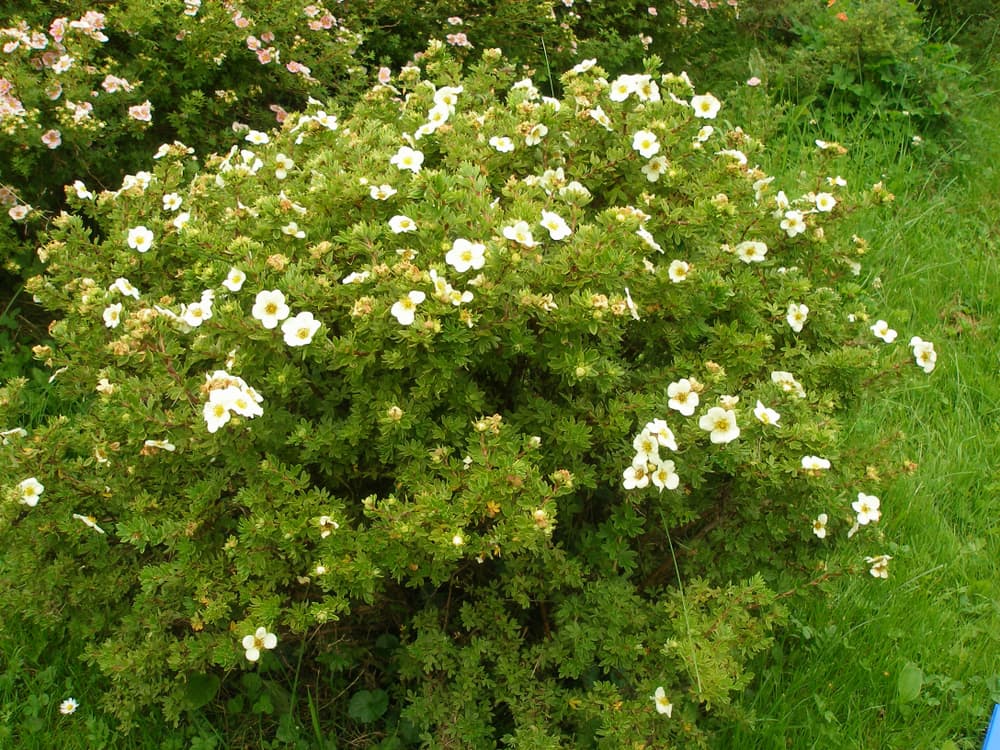
In terms of preferred climate and prospect, potentillas are very hardy and can withstand lots of buffeting from the elements.
This makes them popular choices for beachfront properties, or gardens that are very exposed.
Your potentilla will do best in soil that can drain well, with neutral or slightly acidic pH levels.
A spot with full sun will help to nurture more flower growth, so bear this in mind if you’re growing potentilla especially for its floral bloom.
Plant Care
Watering
To encourage strong root growth keep your potentilla well watered during its first year.
After that, the plant is sturdy enough to tolerate drought, but will appreciate watering in particularly dry conditions.
To insure against various potential health problems (addressed in detail later), try your best to water the roots and soil only, rather than spraying the entire plant.
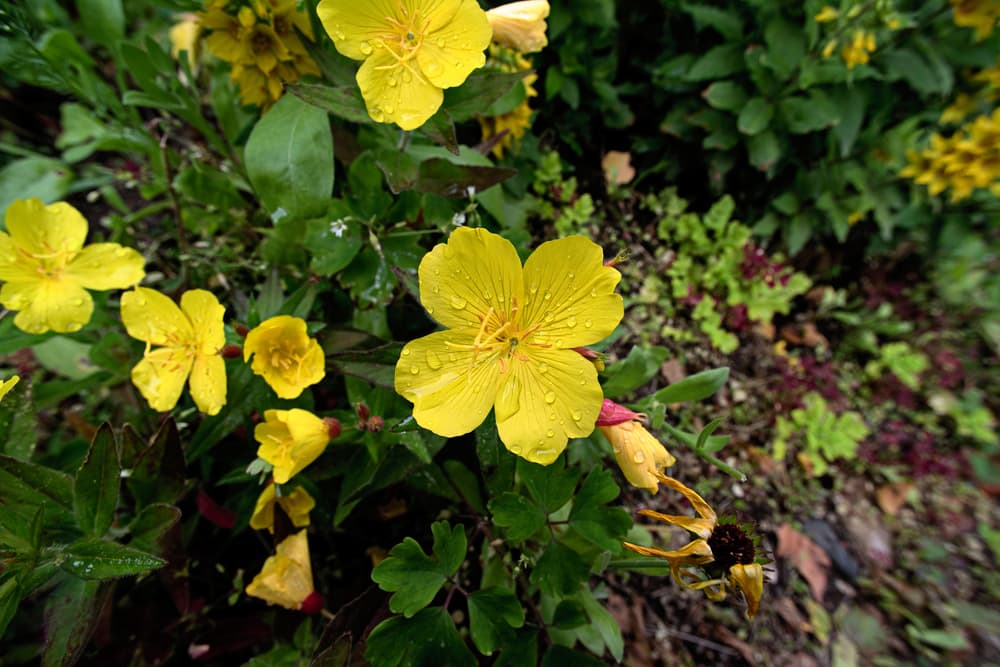
Damp foliage and leaves can cause problems if they’re unable to dry out fully.
Pruning
You don’t need to deadhead the flowers on your potentilla, as they’re able to take care of themselves.
Because of their shrubby nature, potentillas lend themselves well to pruning to keep them in shape.
Don’t do this until your plant is at least three years old, however, to ensure it’s strong enough to withstand the treatment.
Prune back older plants by a third of their total growth every few years to keep them tame and healthy.
“As well as the shrubs, there are many species and cultivars of perennial Potentilla,” shares Colin Skelly, a Master Horticulturist.
“These look fantastic in borders mixed with other perennials and they are popular in cottage garden-style planting.
“Flowering from late spring, these perennials will benefit from deadheading, which will help them to flower right through summer and even into early autumn.”
Propagation
In the height of summer you can take cuttings from your potentilla which, when cared for properly, will flourish into new plants.
Keep an eye out for new growth free of flowers with woody stems but around 15cm of soft, green growth.
Then simply plant the cutting a few centimetres into a pot filled with compost, taking care that the leaves don’t touch the compost.
Cover with a plastic bag for the first few weeks, and then remove the bag once the cutting has had a chance to put out roots.
In the next growing season your potentilla will be ready to be transplanted into your garden, following the steps outlined above.
Common Problems
While generally very hardy, there are a few problems that can affect potentilla. Here’s what to look out for:
Mildew / Leafspot
If you’re too enthusiastic with watering your potentilla, it’s possible the plant will not be able to dry out properly.
Damp leaves and foliage are particularly susceptible to mildew and similar types of rot.
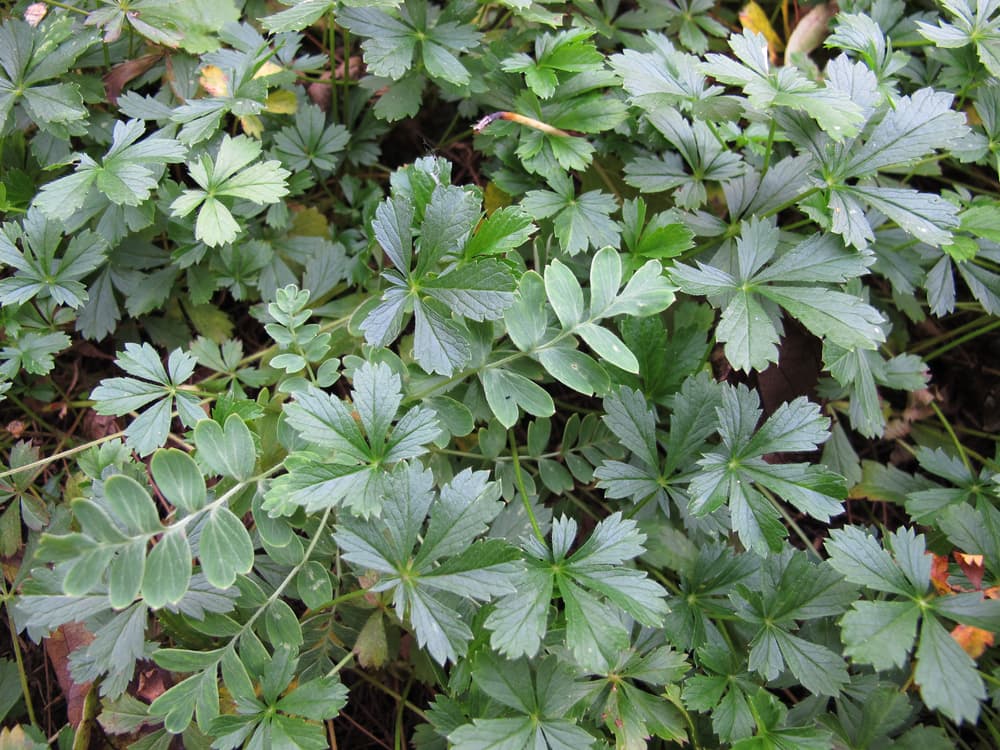
Removing affected parts of the plant before the problem spreads is your best means of control, but in this instance, prevention really is the best cure.
Root Rot
In a similar vein, if the soil is unable to drain properly, your potentilla’s roots may begin to rot.
If this happens, it’s very hard to reverse the course of the rot, and often the plant must be discarded.
Aphids
These pesky green critters love to feast on the sweet fluids inside the leaves and stems of pretty much any plant they can get their hands on (figuratively speaking).
If you notice an unwelcome gathering of green fiends on the leaves of your potentilla, here’s what to do:
- Attempt to remove them by hand, staying vigilant for the next few days to see whether they return.
- Introduce predatory bugs like ladybirds or similar, who will keep the aphid populations in check while not eating your plants.
- Use a pesticide to remove existing populations and discourage further visits. We recommend going for something gentle and humane, although you have a wide range of options when choosing such a product.

The myriad plants under the potentilla banner offer an exciting and rewarding set of blooms for your garden.
Thanks to their hardiness, flexibility, and comprehensive range of shapes, sizes, and colours, there’s a member of the potentilla family well-suited to the needs of any and all gardeners.
Take care to choose the right spot and nurture your plant to health, and you’ll be rewarded with a mature bloom that largely takes care of itself.
References
- 1Potentilla. (n.d.). Plants of the World Online. Retrieved July 31, 2023, from https://powo.science.kew.org/taxon/urn:lsid:ipni.org:names:30000237-2#children
